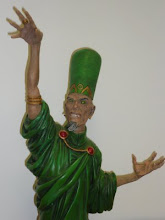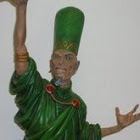 A superhero coming-of-age story that I did not find engaging, the writing, art and colours are all excellent, the combined package did not capture me. In the city of Arcopolis monsters roam kidnapping children for unknown purposes. Haggard West is a genius vigilante who is trying to protect the city, until he is murdered by the monsters.This leaves the city and his daughter Aurora shocked and grieving and the monsters celebrating. On another plane of existence a 12 year boy, just ahead of his 13th birthday is send to Arcopolis to help the city. Battling Boy as he becomes known is celebrated as a new protector for the city which places him in the cross hairs for the monsters and Aurora West. The story unfolds in unexpected ways, the reveals are very well staged and the action is superb.
A superhero coming-of-age story that I did not find engaging, the writing, art and colours are all excellent, the combined package did not capture me. In the city of Arcopolis monsters roam kidnapping children for unknown purposes. Haggard West is a genius vigilante who is trying to protect the city, until he is murdered by the monsters.This leaves the city and his daughter Aurora shocked and grieving and the monsters celebrating. On another plane of existence a 12 year boy, just ahead of his 13th birthday is send to Arcopolis to help the city. Battling Boy as he becomes known is celebrated as a new protector for the city which places him in the cross hairs for the monsters and Aurora West. The story unfolds in unexpected ways, the reveals are very well staged and the action is superb.Paul Pope has taken an unusual approach to a superhero story, it is an origin story of sorts, Battling Boy finds himself in an overwhelming situation and how he will resolve the problems is left open. He may become the help that Arcoplis needs or he may fail, the story leaves the possibilities open. Aurora West is a compelling character, having lost her father she considers his legacy and position to be rightfully hers only to see some stranger step into the space instead. Her coming-of-age is just as disorientating as Battling Boy's and conflict between them seems inevitable, at a time when acting together might be what Arcopolis needs. Paul Pope gives the supporting cast a lot of room to develop and make their presence felt, from Battling Boy's parents to the monsters and the besieged Mayor of Arcopolis they all allowed the space to establish themselves.
The art is vivid and fantastically expressive, the cast fit into their contexts naturally and all of them move with wonderful physical force and grace. The action is dramatic with a careful use of long shots and close ups to frame the action and draw the reader in. The quiet moments work just as well with the body language of the cast providing a clear extra dimension to the words.
The colours by Hilary Sycamore are bright and vivid, they give the city and cast depth and solidity, the damage that the monsters do feels forceful.
The mysterious spark between a reader and a comic that draws in the reader and gets them involved in the story never happened when I read this comic, I admire it, I did not enjoy it as I hoped to do. The story has enough of the elements that I have enjoyed in other stories and look for in stories to have made it a strong candidate for me. The fact that I did not catch it is no criticism of the strongly talented creators, it is just one of those things.





